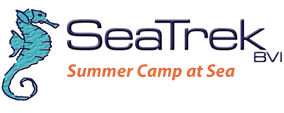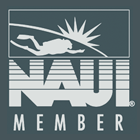This Island Times blog entry is part of a series of personal essays illustrating how SeaTrek has impacted the lives of our students and staff. We thank Dakota Fenn, former student/intern and current staff member, for this insightful look into “NAUI’s Rescue Diver Course” with SeaTrek BVI.
Ever since I was a little kid, I’ve loved being in the water. I prided myself on being able to handle myself in the water, whether that was in the waves of the ocean or the stillness of a swimming pool. However, when I began SCUBA diving at the tender age of twelve, I began to think more carefully about exactly what safety in the water meant to me, and what I needed to do to ensure that I could take care of myself and the people around me.
My journey to competency in SCUBA safety truly began with the NAUI Rescue Diver course I took with SeaTrek BVI three summers ago. I remember carefully filling out my workbook in the weeks leading up to the class, perusing the information on the remedies to various maladies and injuries. I pictured myself carrying out the steps listed for a surface rescue, or performing a transport on an unconscious victim. At long last, I was off to the British Virgin Islands, on my way to one of the most spectacular experiences of my life that would leave me feeling a sense of confidence I’d never thought I’d possess.
The name of my instructor was Capt. Jones (aka. Farva). If you want to know the origin behind the namesake, Farva, ask him – he loves to tell the story. Over the course of several days, he would use a combination of lectures and water work to turn a bunch of green Open Water SCUBA divers into competent Rescue Divers.
Farva’s lectures took the information from the textbook and brought it to life. With a plethora of stories of actual events, Farva implanted the treatments for diving injuries in our minds. We efficiently covered the entirety of the material, absorbing it quickly through Farva’s use of anecdotes.
We also splashed into the water to train ourselves in the techniques necessary to complete a rescue. From throw bags to rescue breaths, we learned it all. A particular highlight was when a smaller one of my fellow trainees attempted to carry Farva, a rather large man, up the beach using one of the methods we had just been taught.
The culmination of the Rescue Diver class at SeaTrek is a full-blown (spontaneous) rescue scenario. Having both participated in and helped with the staging of the scenario, I can attest to the ability of the students to execute the plan for rescue. My class succeeded the very first attempt, an unusual feat by all accounts, but hey, we were just that good I suppose.
As a result of SeaTrek’s Rescue Diver course, I gained a sense of confidence in my skills that I’ve only expanded upon throughout my continued diving education. And though I may continue to build upon that foundation, I can attribute all of my current knowledge and self-reliance back to the class that Farva taught me so long ago. And I will most certainly take with me and apply the skills and lessons he taught me as I pursue my NAUI Instructor Certification next summer.




